Auckland International Campus: Applied Management Report (CX553001)
VerifiedAdded on 2023/05/31
|16
|3681
|146
Report
AI Summary
This report, prepared for the Bachelor of Applied Management program, delves into crucial management concepts through a comprehensive analysis. The report begins by examining motivational theories, specifically Maslow's hierarchy of needs and Herzberg's two-factor theory, and their application to Simunovich Olive Estate. It then explores leadership styles, contrasting the democratic leadership of 2 degrees mobile's CEO, Stewart Sherriff, with the charismatic leadership of Donna Simunovich. The report further investigates delegation strategies within 2 degrees mobile, outlining a six-step delegation process. Change management is addressed using Kurt Lewin's change model, analyzing the introduction of 4G networks, and the whitewater metaphor. The report concludes by discussing the forces driving innovation and change, particularly technological advancements and competition, and presents strategies for overcoming barriers to change within Simunovich Olive Estate. The report uses real-world examples to illustrate the application of these theories and concepts.
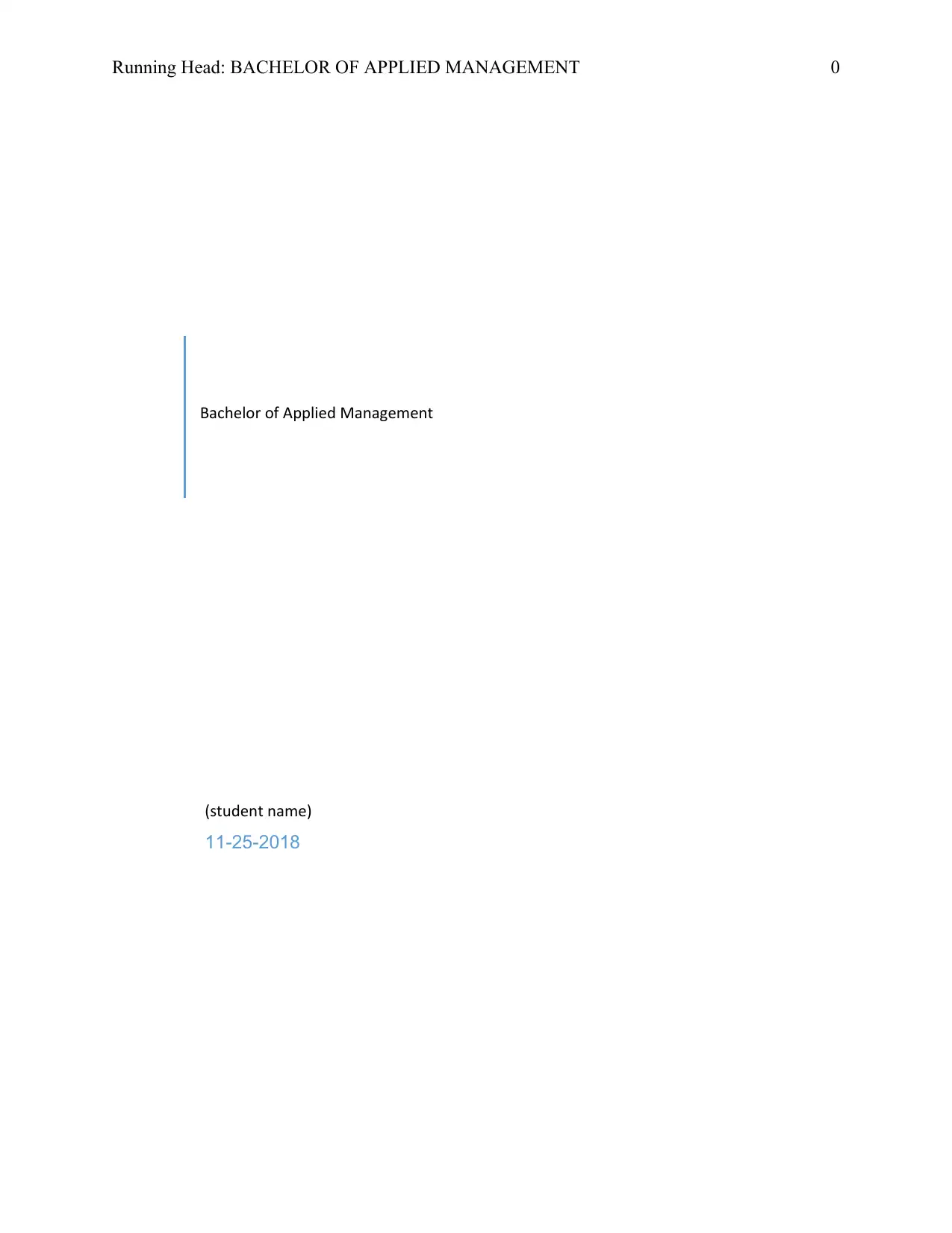
Running Head: BACHELOR OF APPLIED MANAGEMENT 0
Bachelor of Applied Management
(student name)
11-25-2018
Bachelor of Applied Management
(student name)
11-25-2018
Paraphrase This Document
Need a fresh take? Get an instant paraphrase of this document with our AI Paraphraser
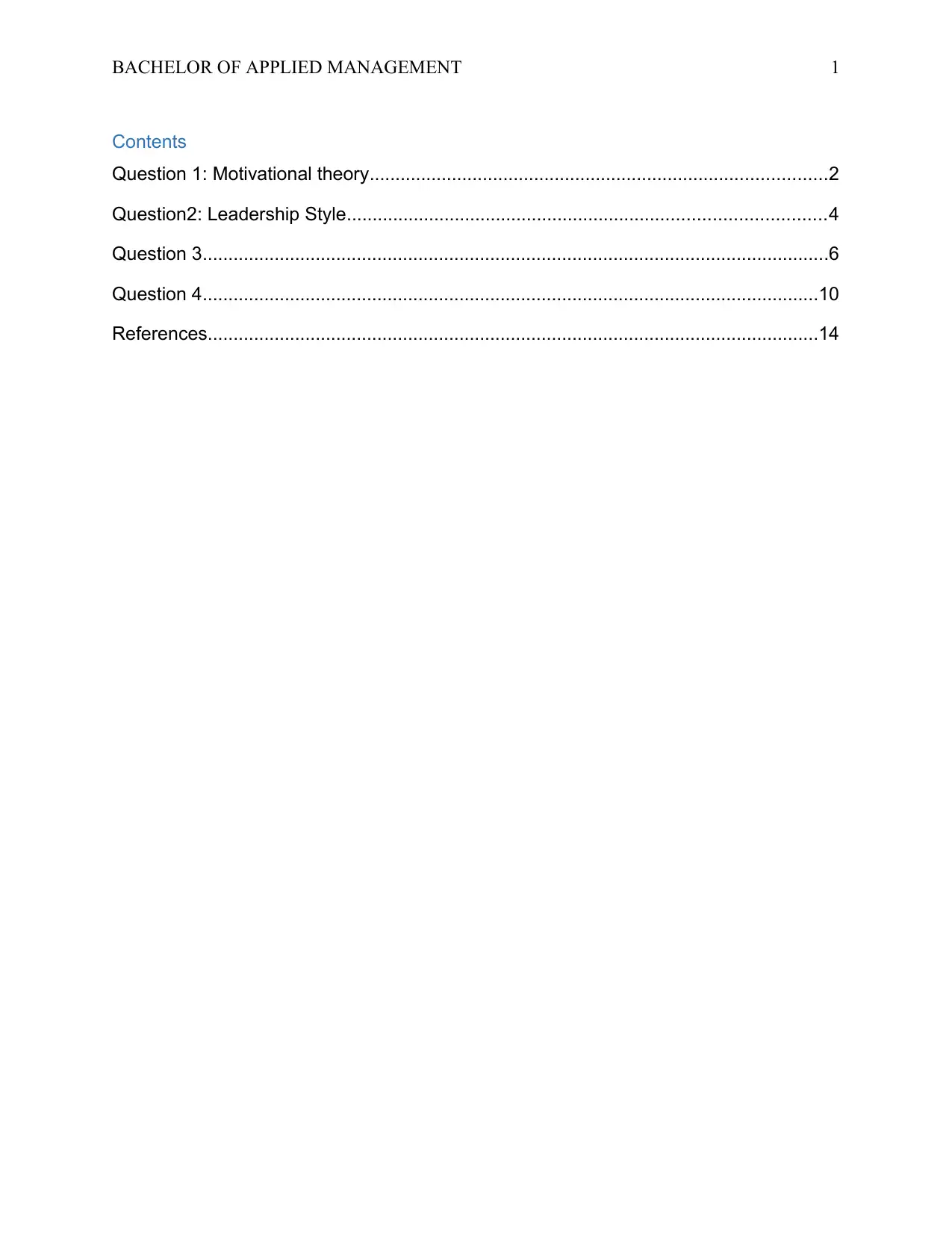
BACHELOR OF APPLIED MANAGEMENT 1
Contents
Question 1: Motivational theory.........................................................................................2
Question2: Leadership Style.............................................................................................4
Question 3..........................................................................................................................6
Question 4........................................................................................................................10
References.......................................................................................................................14
Contents
Question 1: Motivational theory.........................................................................................2
Question2: Leadership Style.............................................................................................4
Question 3..........................................................................................................................6
Question 4........................................................................................................................10
References.......................................................................................................................14
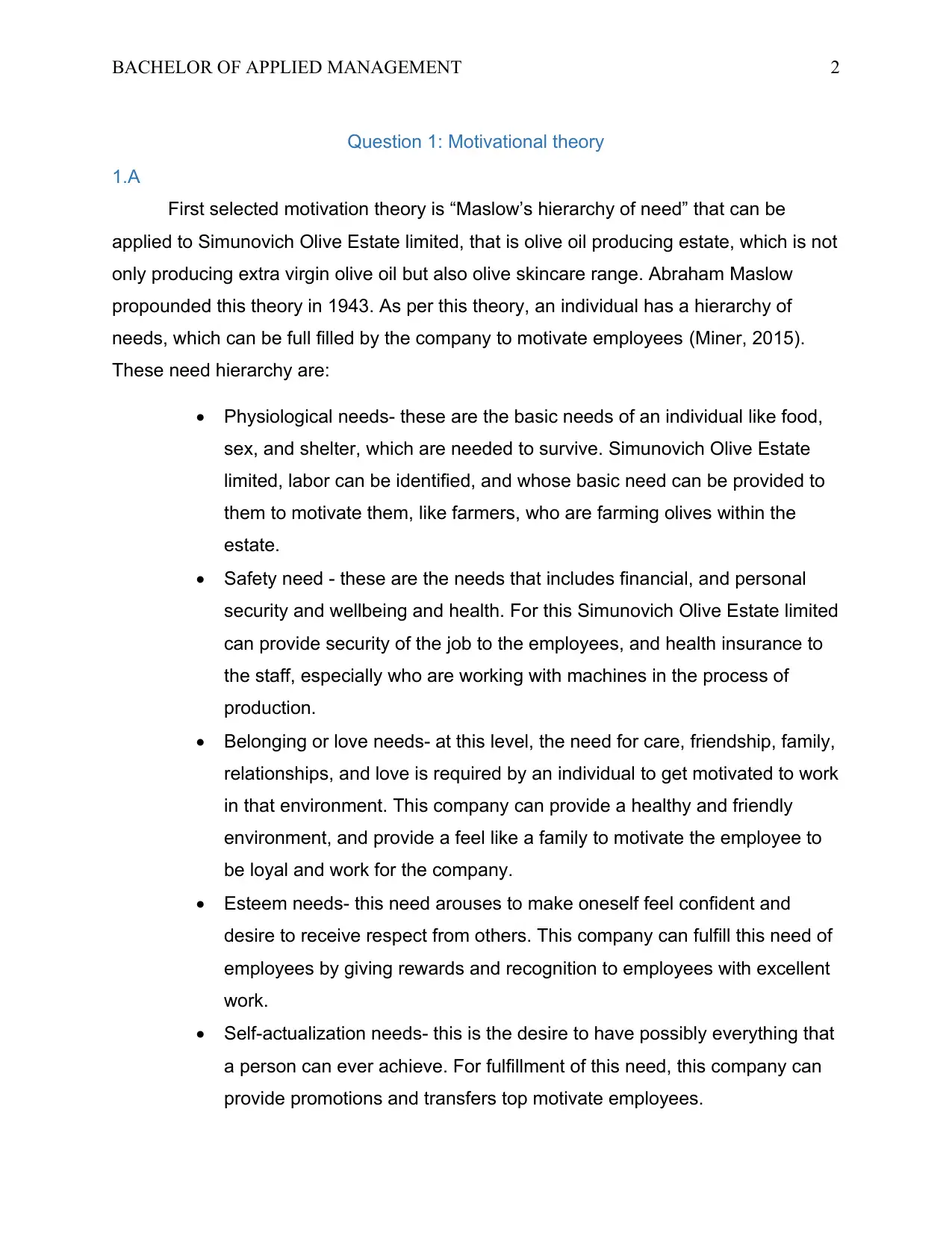
BACHELOR OF APPLIED MANAGEMENT 2
Question 1: Motivational theory
1.A
First selected motivation theory is “Maslow’s hierarchy of need” that can be
applied to Simunovich Olive Estate limited, that is olive oil producing estate, which is not
only producing extra virgin olive oil but also olive skincare range. Abraham Maslow
propounded this theory in 1943. As per this theory, an individual has a hierarchy of
needs, which can be full filled by the company to motivate employees (Miner, 2015).
These need hierarchy are:
Physiological needs- these are the basic needs of an individual like food,
sex, and shelter, which are needed to survive. Simunovich Olive Estate
limited, labor can be identified, and whose basic need can be provided to
them to motivate them, like farmers, who are farming olives within the
estate.
Safety need - these are the needs that includes financial, and personal
security and wellbeing and health. For this Simunovich Olive Estate limited
can provide security of the job to the employees, and health insurance to
the staff, especially who are working with machines in the process of
production.
Belonging or love needs- at this level, the need for care, friendship, family,
relationships, and love is required by an individual to get motivated to work
in that environment. This company can provide a healthy and friendly
environment, and provide a feel like a family to motivate the employee to
be loyal and work for the company.
Esteem needs- this need arouses to make oneself feel confident and
desire to receive respect from others. This company can fulfill this need of
employees by giving rewards and recognition to employees with excellent
work.
Self-actualization needs- this is the desire to have possibly everything that
a person can ever achieve. For fulfillment of this need, this company can
provide promotions and transfers top motivate employees.
Question 1: Motivational theory
1.A
First selected motivation theory is “Maslow’s hierarchy of need” that can be
applied to Simunovich Olive Estate limited, that is olive oil producing estate, which is not
only producing extra virgin olive oil but also olive skincare range. Abraham Maslow
propounded this theory in 1943. As per this theory, an individual has a hierarchy of
needs, which can be full filled by the company to motivate employees (Miner, 2015).
These need hierarchy are:
Physiological needs- these are the basic needs of an individual like food,
sex, and shelter, which are needed to survive. Simunovich Olive Estate
limited, labor can be identified, and whose basic need can be provided to
them to motivate them, like farmers, who are farming olives within the
estate.
Safety need - these are the needs that includes financial, and personal
security and wellbeing and health. For this Simunovich Olive Estate limited
can provide security of the job to the employees, and health insurance to
the staff, especially who are working with machines in the process of
production.
Belonging or love needs- at this level, the need for care, friendship, family,
relationships, and love is required by an individual to get motivated to work
in that environment. This company can provide a healthy and friendly
environment, and provide a feel like a family to motivate the employee to
be loyal and work for the company.
Esteem needs- this need arouses to make oneself feel confident and
desire to receive respect from others. This company can fulfill this need of
employees by giving rewards and recognition to employees with excellent
work.
Self-actualization needs- this is the desire to have possibly everything that
a person can ever achieve. For fulfillment of this need, this company can
provide promotions and transfers top motivate employees.
⊘ This is a preview!⊘
Do you want full access?
Subscribe today to unlock all pages.

Trusted by 1+ million students worldwide
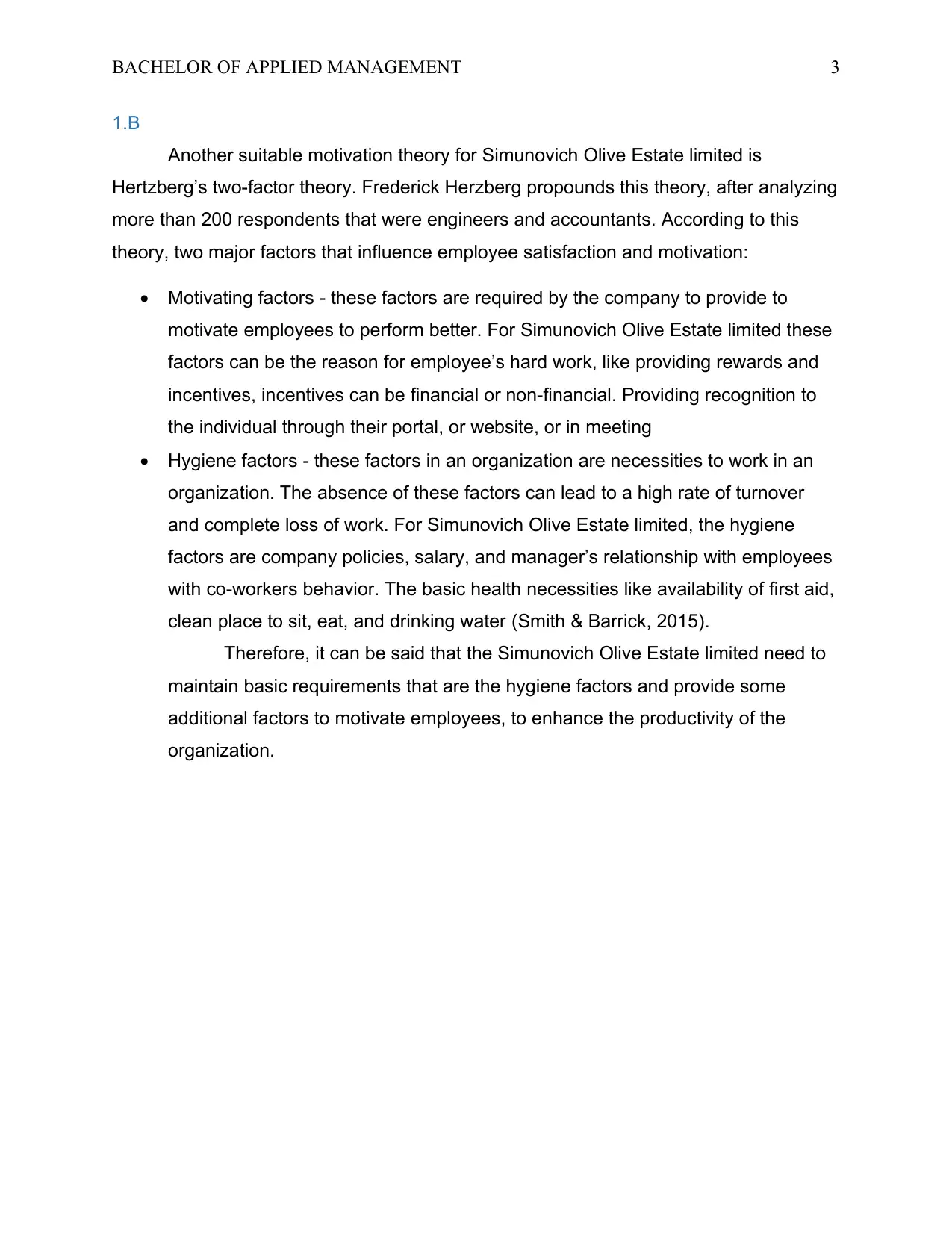
BACHELOR OF APPLIED MANAGEMENT 3
1.B
Another suitable motivation theory for Simunovich Olive Estate limited is
Hertzberg’s two-factor theory. Frederick Herzberg propounds this theory, after analyzing
more than 200 respondents that were engineers and accountants. According to this
theory, two major factors that influence employee satisfaction and motivation:
Motivating factors - these factors are required by the company to provide to
motivate employees to perform better. For Simunovich Olive Estate limited these
factors can be the reason for employee’s hard work, like providing rewards and
incentives, incentives can be financial or non-financial. Providing recognition to
the individual through their portal, or website, or in meeting
Hygiene factors - these factors in an organization are necessities to work in an
organization. The absence of these factors can lead to a high rate of turnover
and complete loss of work. For Simunovich Olive Estate limited, the hygiene
factors are company policies, salary, and manager’s relationship with employees
with co-workers behavior. The basic health necessities like availability of first aid,
clean place to sit, eat, and drinking water (Smith & Barrick, 2015).
Therefore, it can be said that the Simunovich Olive Estate limited need to
maintain basic requirements that are the hygiene factors and provide some
additional factors to motivate employees, to enhance the productivity of the
organization.
1.B
Another suitable motivation theory for Simunovich Olive Estate limited is
Hertzberg’s two-factor theory. Frederick Herzberg propounds this theory, after analyzing
more than 200 respondents that were engineers and accountants. According to this
theory, two major factors that influence employee satisfaction and motivation:
Motivating factors - these factors are required by the company to provide to
motivate employees to perform better. For Simunovich Olive Estate limited these
factors can be the reason for employee’s hard work, like providing rewards and
incentives, incentives can be financial or non-financial. Providing recognition to
the individual through their portal, or website, or in meeting
Hygiene factors - these factors in an organization are necessities to work in an
organization. The absence of these factors can lead to a high rate of turnover
and complete loss of work. For Simunovich Olive Estate limited, the hygiene
factors are company policies, salary, and manager’s relationship with employees
with co-workers behavior. The basic health necessities like availability of first aid,
clean place to sit, eat, and drinking water (Smith & Barrick, 2015).
Therefore, it can be said that the Simunovich Olive Estate limited need to
maintain basic requirements that are the hygiene factors and provide some
additional factors to motivate employees, to enhance the productivity of the
organization.
Paraphrase This Document
Need a fresh take? Get an instant paraphrase of this document with our AI Paraphraser
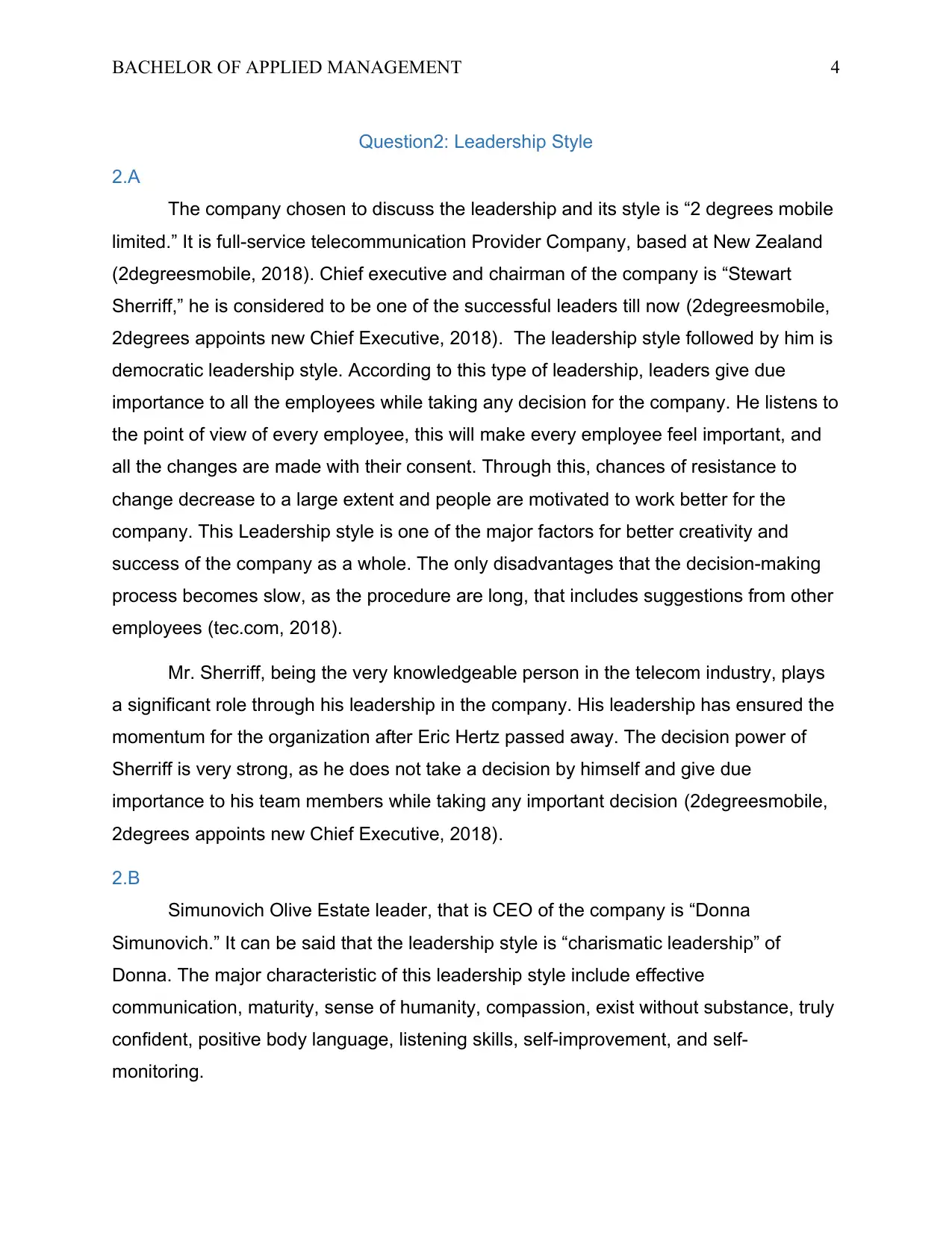
BACHELOR OF APPLIED MANAGEMENT 4
Question2: Leadership Style
2.A
The company chosen to discuss the leadership and its style is “2 degrees mobile
limited.” It is full-service telecommunication Provider Company, based at New Zealand
(2degreesmobile, 2018). Chief executive and chairman of the company is “Stewart
Sherriff,” he is considered to be one of the successful leaders till now (2degreesmobile,
2degrees appoints new Chief Executive, 2018). The leadership style followed by him is
democratic leadership style. According to this type of leadership, leaders give due
importance to all the employees while taking any decision for the company. He listens to
the point of view of every employee, this will make every employee feel important, and
all the changes are made with their consent. Through this, chances of resistance to
change decrease to a large extent and people are motivated to work better for the
company. This Leadership style is one of the major factors for better creativity and
success of the company as a whole. The only disadvantages that the decision-making
process becomes slow, as the procedure are long, that includes suggestions from other
employees (tec.com, 2018).
Mr. Sherriff, being the very knowledgeable person in the telecom industry, plays
a significant role through his leadership in the company. His leadership has ensured the
momentum for the organization after Eric Hertz passed away. The decision power of
Sherriff is very strong, as he does not take a decision by himself and give due
importance to his team members while taking any important decision (2degreesmobile,
2degrees appoints new Chief Executive, 2018).
2.B
Simunovich Olive Estate leader, that is CEO of the company is “Donna
Simunovich.” It can be said that the leadership style is “charismatic leadership” of
Donna. The major characteristic of this leadership style include effective
communication, maturity, sense of humanity, compassion, exist without substance, truly
confident, positive body language, listening skills, self-improvement, and self-
monitoring.
Question2: Leadership Style
2.A
The company chosen to discuss the leadership and its style is “2 degrees mobile
limited.” It is full-service telecommunication Provider Company, based at New Zealand
(2degreesmobile, 2018). Chief executive and chairman of the company is “Stewart
Sherriff,” he is considered to be one of the successful leaders till now (2degreesmobile,
2degrees appoints new Chief Executive, 2018). The leadership style followed by him is
democratic leadership style. According to this type of leadership, leaders give due
importance to all the employees while taking any decision for the company. He listens to
the point of view of every employee, this will make every employee feel important, and
all the changes are made with their consent. Through this, chances of resistance to
change decrease to a large extent and people are motivated to work better for the
company. This Leadership style is one of the major factors for better creativity and
success of the company as a whole. The only disadvantages that the decision-making
process becomes slow, as the procedure are long, that includes suggestions from other
employees (tec.com, 2018).
Mr. Sherriff, being the very knowledgeable person in the telecom industry, plays
a significant role through his leadership in the company. His leadership has ensured the
momentum for the organization after Eric Hertz passed away. The decision power of
Sherriff is very strong, as he does not take a decision by himself and give due
importance to his team members while taking any important decision (2degreesmobile,
2degrees appoints new Chief Executive, 2018).
2.B
Simunovich Olive Estate leader, that is CEO of the company is “Donna
Simunovich.” It can be said that the leadership style is “charismatic leadership” of
Donna. The major characteristic of this leadership style include effective
communication, maturity, sense of humanity, compassion, exist without substance, truly
confident, positive body language, listening skills, self-improvement, and self-
monitoring.
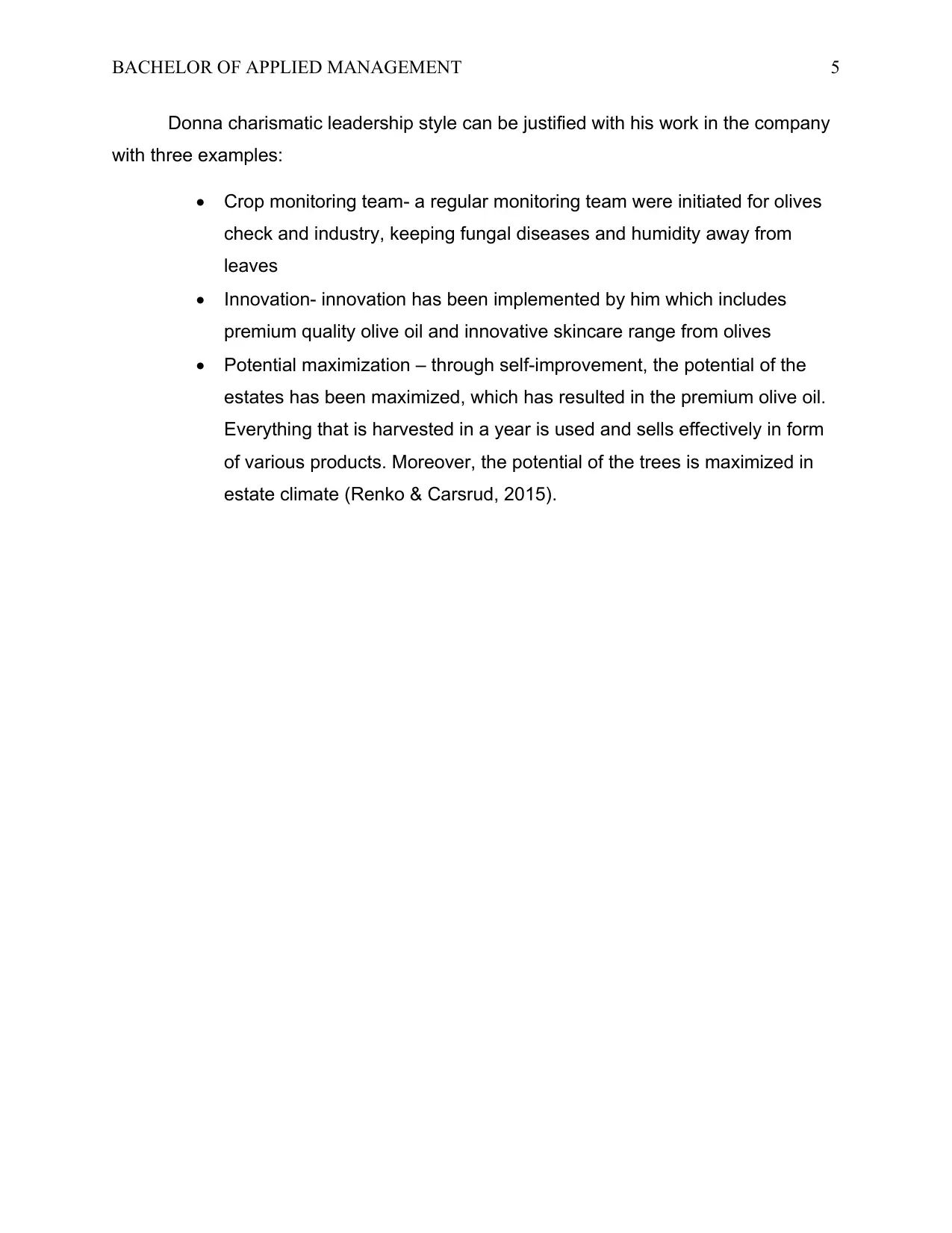
BACHELOR OF APPLIED MANAGEMENT 5
Donna charismatic leadership style can be justified with his work in the company
with three examples:
Crop monitoring team- a regular monitoring team were initiated for olives
check and industry, keeping fungal diseases and humidity away from
leaves
Innovation- innovation has been implemented by him which includes
premium quality olive oil and innovative skincare range from olives
Potential maximization – through self-improvement, the potential of the
estates has been maximized, which has resulted in the premium olive oil.
Everything that is harvested in a year is used and sells effectively in form
of various products. Moreover, the potential of the trees is maximized in
estate climate (Renko & Carsrud, 2015).
Donna charismatic leadership style can be justified with his work in the company
with three examples:
Crop monitoring team- a regular monitoring team were initiated for olives
check and industry, keeping fungal diseases and humidity away from
leaves
Innovation- innovation has been implemented by him which includes
premium quality olive oil and innovative skincare range from olives
Potential maximization – through self-improvement, the potential of the
estates has been maximized, which has resulted in the premium olive oil.
Everything that is harvested in a year is used and sells effectively in form
of various products. Moreover, the potential of the trees is maximized in
estate climate (Renko & Carsrud, 2015).
⊘ This is a preview!⊘
Do you want full access?
Subscribe today to unlock all pages.

Trusted by 1+ million students worldwide
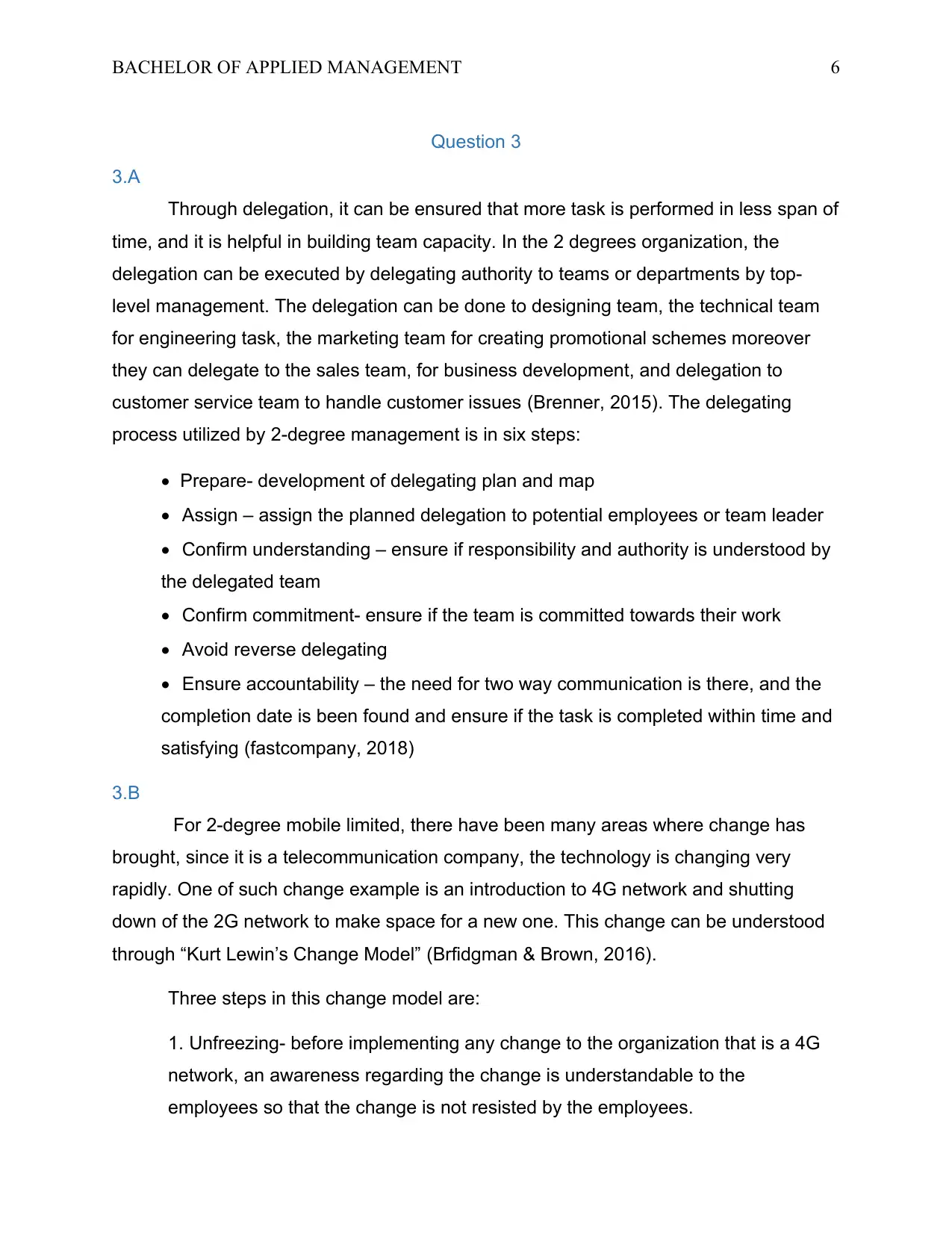
BACHELOR OF APPLIED MANAGEMENT 6
Question 3
3.A
Through delegation, it can be ensured that more task is performed in less span of
time, and it is helpful in building team capacity. In the 2 degrees organization, the
delegation can be executed by delegating authority to teams or departments by top-
level management. The delegation can be done to designing team, the technical team
for engineering task, the marketing team for creating promotional schemes moreover
they can delegate to the sales team, for business development, and delegation to
customer service team to handle customer issues (Brenner, 2015). The delegating
process utilized by 2-degree management is in six steps:
Prepare- development of delegating plan and map
Assign – assign the planned delegation to potential employees or team leader
Confirm understanding – ensure if responsibility and authority is understood by
the delegated team
Confirm commitment- ensure if the team is committed towards their work
Avoid reverse delegating
Ensure accountability – the need for two way communication is there, and the
completion date is been found and ensure if the task is completed within time and
satisfying (fastcompany, 2018)
3.B
For 2-degree mobile limited, there have been many areas where change has
brought, since it is a telecommunication company, the technology is changing very
rapidly. One of such change example is an introduction to 4G network and shutting
down of the 2G network to make space for a new one. This change can be understood
through “Kurt Lewin’s Change Model” (Brfidgman & Brown, 2016).
Three steps in this change model are:
1. Unfreezing- before implementing any change to the organization that is a 4G
network, an awareness regarding the change is understandable to the
employees so that the change is not resisted by the employees.
Question 3
3.A
Through delegation, it can be ensured that more task is performed in less span of
time, and it is helpful in building team capacity. In the 2 degrees organization, the
delegation can be executed by delegating authority to teams or departments by top-
level management. The delegation can be done to designing team, the technical team
for engineering task, the marketing team for creating promotional schemes moreover
they can delegate to the sales team, for business development, and delegation to
customer service team to handle customer issues (Brenner, 2015). The delegating
process utilized by 2-degree management is in six steps:
Prepare- development of delegating plan and map
Assign – assign the planned delegation to potential employees or team leader
Confirm understanding – ensure if responsibility and authority is understood by
the delegated team
Confirm commitment- ensure if the team is committed towards their work
Avoid reverse delegating
Ensure accountability – the need for two way communication is there, and the
completion date is been found and ensure if the task is completed within time and
satisfying (fastcompany, 2018)
3.B
For 2-degree mobile limited, there have been many areas where change has
brought, since it is a telecommunication company, the technology is changing very
rapidly. One of such change example is an introduction to 4G network and shutting
down of the 2G network to make space for a new one. This change can be understood
through “Kurt Lewin’s Change Model” (Brfidgman & Brown, 2016).
Three steps in this change model are:
1. Unfreezing- before implementing any change to the organization that is a 4G
network, an awareness regarding the change is understandable to the
employees so that the change is not resisted by the employees.
Paraphrase This Document
Need a fresh take? Get an instant paraphrase of this document with our AI Paraphraser
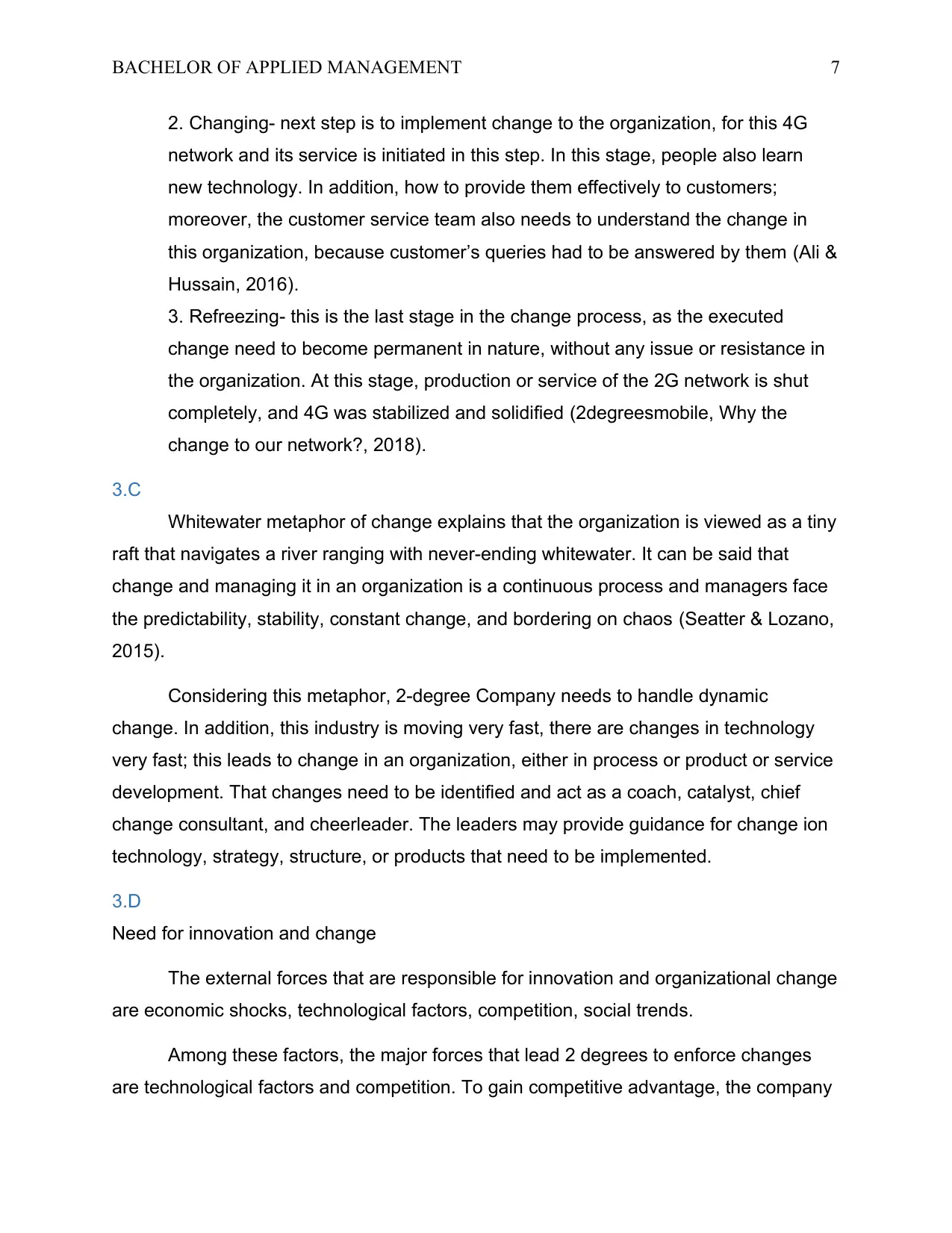
BACHELOR OF APPLIED MANAGEMENT 7
2. Changing- next step is to implement change to the organization, for this 4G
network and its service is initiated in this step. In this stage, people also learn
new technology. In addition, how to provide them effectively to customers;
moreover, the customer service team also needs to understand the change in
this organization, because customer’s queries had to be answered by them (Ali &
Hussain, 2016).
3. Refreezing- this is the last stage in the change process, as the executed
change need to become permanent in nature, without any issue or resistance in
the organization. At this stage, production or service of the 2G network is shut
completely, and 4G was stabilized and solidified (2degreesmobile, Why the
change to our network?, 2018).
3.C
Whitewater metaphor of change explains that the organization is viewed as a tiny
raft that navigates a river ranging with never-ending whitewater. It can be said that
change and managing it in an organization is a continuous process and managers face
the predictability, stability, constant change, and bordering on chaos (Seatter & Lozano,
2015).
Considering this metaphor, 2-degree Company needs to handle dynamic
change. In addition, this industry is moving very fast, there are changes in technology
very fast; this leads to change in an organization, either in process or product or service
development. That changes need to be identified and act as a coach, catalyst, chief
change consultant, and cheerleader. The leaders may provide guidance for change ion
technology, strategy, structure, or products that need to be implemented.
3.D
Need for innovation and change
The external forces that are responsible for innovation and organizational change
are economic shocks, technological factors, competition, social trends.
Among these factors, the major forces that lead 2 degrees to enforce changes
are technological factors and competition. To gain competitive advantage, the company
2. Changing- next step is to implement change to the organization, for this 4G
network and its service is initiated in this step. In this stage, people also learn
new technology. In addition, how to provide them effectively to customers;
moreover, the customer service team also needs to understand the change in
this organization, because customer’s queries had to be answered by them (Ali &
Hussain, 2016).
3. Refreezing- this is the last stage in the change process, as the executed
change need to become permanent in nature, without any issue or resistance in
the organization. At this stage, production or service of the 2G network is shut
completely, and 4G was stabilized and solidified (2degreesmobile, Why the
change to our network?, 2018).
3.C
Whitewater metaphor of change explains that the organization is viewed as a tiny
raft that navigates a river ranging with never-ending whitewater. It can be said that
change and managing it in an organization is a continuous process and managers face
the predictability, stability, constant change, and bordering on chaos (Seatter & Lozano,
2015).
Considering this metaphor, 2-degree Company needs to handle dynamic
change. In addition, this industry is moving very fast, there are changes in technology
very fast; this leads to change in an organization, either in process or product or service
development. That changes need to be identified and act as a coach, catalyst, chief
change consultant, and cheerleader. The leaders may provide guidance for change ion
technology, strategy, structure, or products that need to be implemented.
3.D
Need for innovation and change
The external forces that are responsible for innovation and organizational change
are economic shocks, technological factors, competition, social trends.
Among these factors, the major forces that lead 2 degrees to enforce changes
are technological factors and competition. To gain competitive advantage, the company
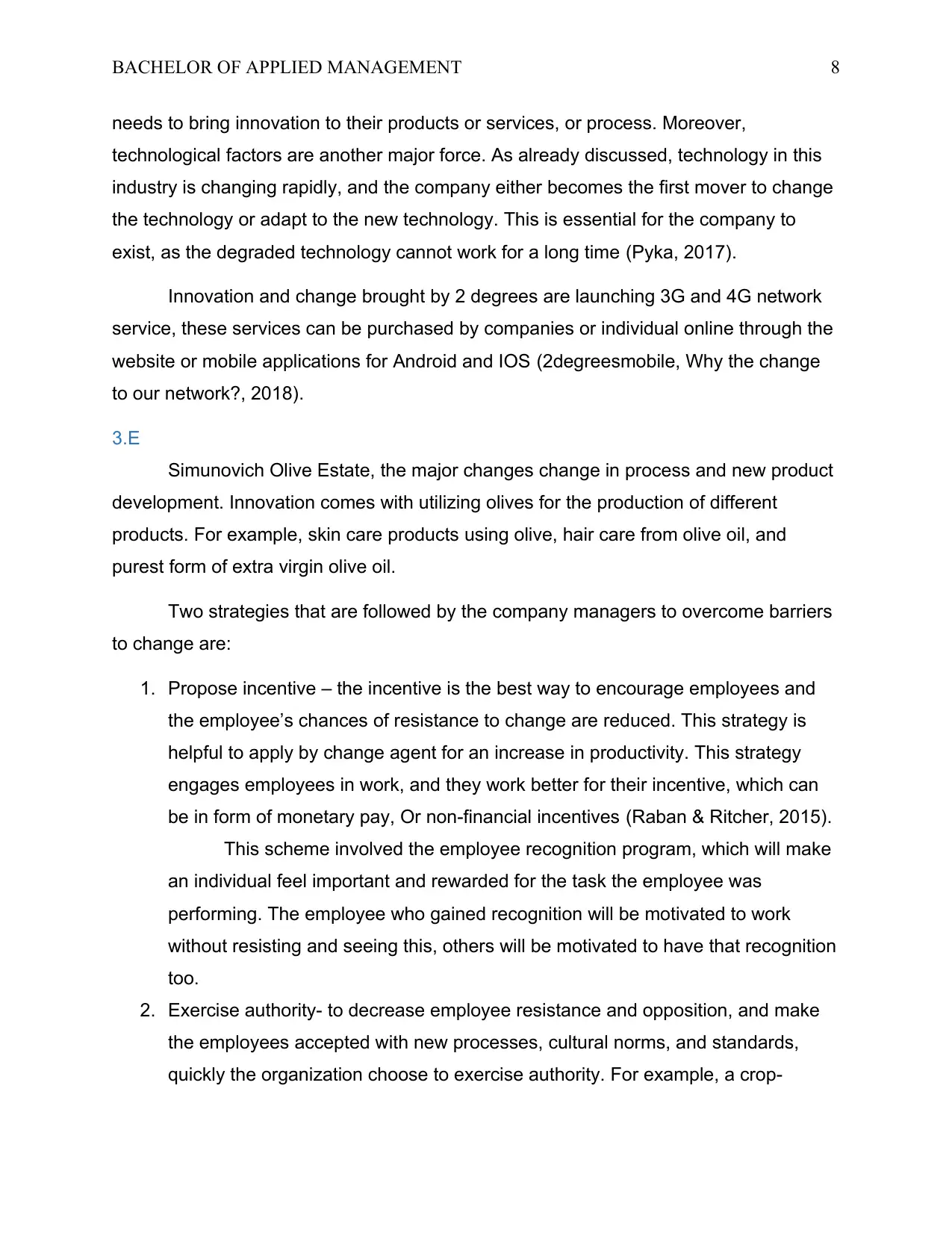
BACHELOR OF APPLIED MANAGEMENT 8
needs to bring innovation to their products or services, or process. Moreover,
technological factors are another major force. As already discussed, technology in this
industry is changing rapidly, and the company either becomes the first mover to change
the technology or adapt to the new technology. This is essential for the company to
exist, as the degraded technology cannot work for a long time (Pyka, 2017).
Innovation and change brought by 2 degrees are launching 3G and 4G network
service, these services can be purchased by companies or individual online through the
website or mobile applications for Android and IOS (2degreesmobile, Why the change
to our network?, 2018).
3.E
Simunovich Olive Estate, the major changes change in process and new product
development. Innovation comes with utilizing olives for the production of different
products. For example, skin care products using olive, hair care from olive oil, and
purest form of extra virgin olive oil.
Two strategies that are followed by the company managers to overcome barriers
to change are:
1. Propose incentive – the incentive is the best way to encourage employees and
the employee’s chances of resistance to change are reduced. This strategy is
helpful to apply by change agent for an increase in productivity. This strategy
engages employees in work, and they work better for their incentive, which can
be in form of monetary pay, Or non-financial incentives (Raban & Ritcher, 2015).
This scheme involved the employee recognition program, which will make
an individual feel important and rewarded for the task the employee was
performing. The employee who gained recognition will be motivated to work
without resisting and seeing this, others will be motivated to have that recognition
too.
2. Exercise authority- to decrease employee resistance and opposition, and make
the employees accepted with new processes, cultural norms, and standards,
quickly the organization choose to exercise authority. For example, a crop-
needs to bring innovation to their products or services, or process. Moreover,
technological factors are another major force. As already discussed, technology in this
industry is changing rapidly, and the company either becomes the first mover to change
the technology or adapt to the new technology. This is essential for the company to
exist, as the degraded technology cannot work for a long time (Pyka, 2017).
Innovation and change brought by 2 degrees are launching 3G and 4G network
service, these services can be purchased by companies or individual online through the
website or mobile applications for Android and IOS (2degreesmobile, Why the change
to our network?, 2018).
3.E
Simunovich Olive Estate, the major changes change in process and new product
development. Innovation comes with utilizing olives for the production of different
products. For example, skin care products using olive, hair care from olive oil, and
purest form of extra virgin olive oil.
Two strategies that are followed by the company managers to overcome barriers
to change are:
1. Propose incentive – the incentive is the best way to encourage employees and
the employee’s chances of resistance to change are reduced. This strategy is
helpful to apply by change agent for an increase in productivity. This strategy
engages employees in work, and they work better for their incentive, which can
be in form of monetary pay, Or non-financial incentives (Raban & Ritcher, 2015).
This scheme involved the employee recognition program, which will make
an individual feel important and rewarded for the task the employee was
performing. The employee who gained recognition will be motivated to work
without resisting and seeing this, others will be motivated to have that recognition
too.
2. Exercise authority- to decrease employee resistance and opposition, and make
the employees accepted with new processes, cultural norms, and standards,
quickly the organization choose to exercise authority. For example, a crop-
⊘ This is a preview!⊘
Do you want full access?
Subscribe today to unlock all pages.

Trusted by 1+ million students worldwide
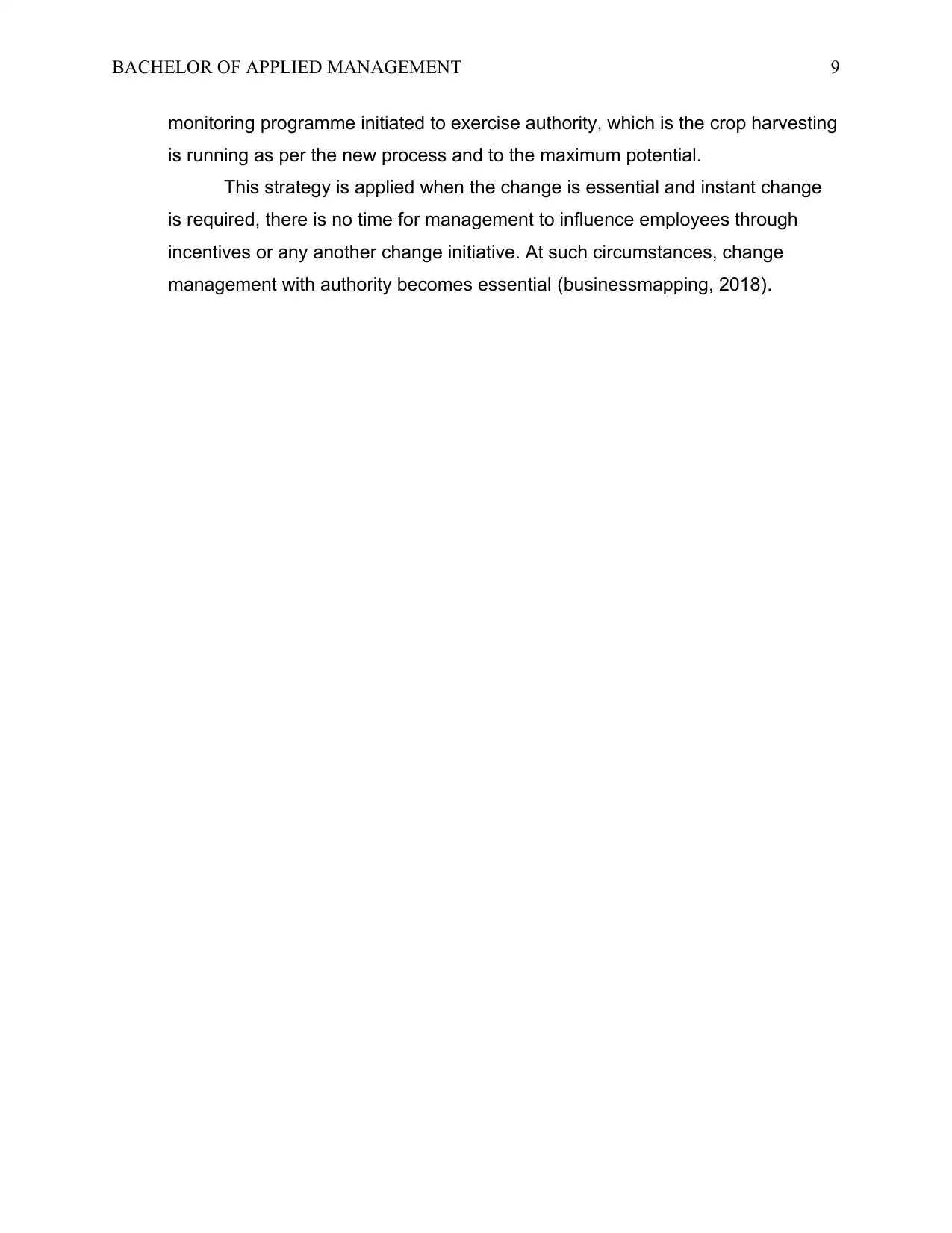
BACHELOR OF APPLIED MANAGEMENT 9
monitoring programme initiated to exercise authority, which is the crop harvesting
is running as per the new process and to the maximum potential.
This strategy is applied when the change is essential and instant change
is required, there is no time for management to influence employees through
incentives or any another change initiative. At such circumstances, change
management with authority becomes essential (businessmapping, 2018).
monitoring programme initiated to exercise authority, which is the crop harvesting
is running as per the new process and to the maximum potential.
This strategy is applied when the change is essential and instant change
is required, there is no time for management to influence employees through
incentives or any another change initiative. At such circumstances, change
management with authority becomes essential (businessmapping, 2018).
Paraphrase This Document
Need a fresh take? Get an instant paraphrase of this document with our AI Paraphraser
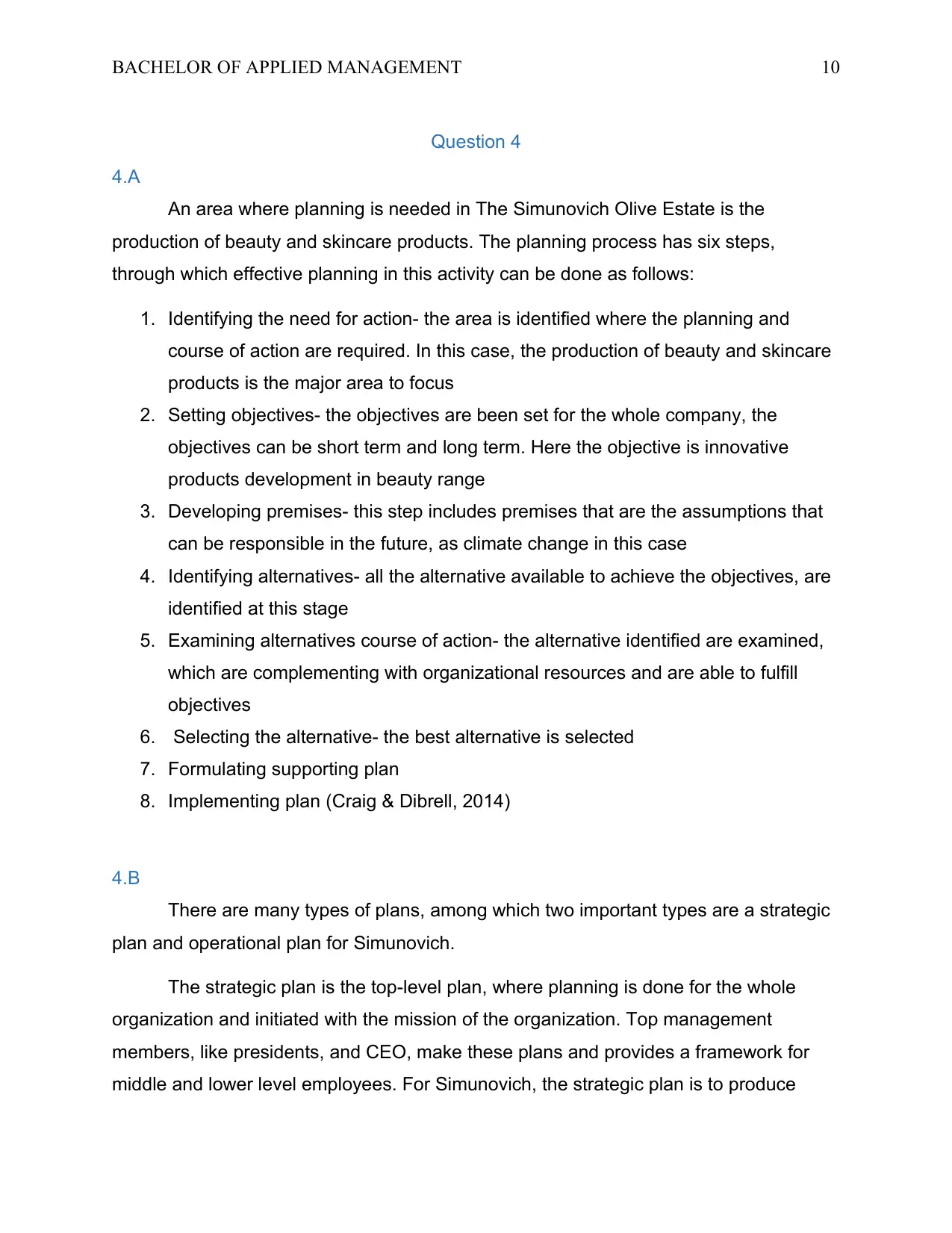
BACHELOR OF APPLIED MANAGEMENT 10
Question 4
4.A
An area where planning is needed in The Simunovich Olive Estate is the
production of beauty and skincare products. The planning process has six steps,
through which effective planning in this activity can be done as follows:
1. Identifying the need for action- the area is identified where the planning and
course of action are required. In this case, the production of beauty and skincare
products is the major area to focus
2. Setting objectives- the objectives are been set for the whole company, the
objectives can be short term and long term. Here the objective is innovative
products development in beauty range
3. Developing premises- this step includes premises that are the assumptions that
can be responsible in the future, as climate change in this case
4. Identifying alternatives- all the alternative available to achieve the objectives, are
identified at this stage
5. Examining alternatives course of action- the alternative identified are examined,
which are complementing with organizational resources and are able to fulfill
objectives
6. Selecting the alternative- the best alternative is selected
7. Formulating supporting plan
8. Implementing plan (Craig & Dibrell, 2014)
4.B
There are many types of plans, among which two important types are a strategic
plan and operational plan for Simunovich.
The strategic plan is the top-level plan, where planning is done for the whole
organization and initiated with the mission of the organization. Top management
members, like presidents, and CEO, make these plans and provides a framework for
middle and lower level employees. For Simunovich, the strategic plan is to produce
Question 4
4.A
An area where planning is needed in The Simunovich Olive Estate is the
production of beauty and skincare products. The planning process has six steps,
through which effective planning in this activity can be done as follows:
1. Identifying the need for action- the area is identified where the planning and
course of action are required. In this case, the production of beauty and skincare
products is the major area to focus
2. Setting objectives- the objectives are been set for the whole company, the
objectives can be short term and long term. Here the objective is innovative
products development in beauty range
3. Developing premises- this step includes premises that are the assumptions that
can be responsible in the future, as climate change in this case
4. Identifying alternatives- all the alternative available to achieve the objectives, are
identified at this stage
5. Examining alternatives course of action- the alternative identified are examined,
which are complementing with organizational resources and are able to fulfill
objectives
6. Selecting the alternative- the best alternative is selected
7. Formulating supporting plan
8. Implementing plan (Craig & Dibrell, 2014)
4.B
There are many types of plans, among which two important types are a strategic
plan and operational plan for Simunovich.
The strategic plan is the top-level plan, where planning is done for the whole
organization and initiated with the mission of the organization. Top management
members, like presidents, and CEO, make these plans and provides a framework for
middle and lower level employees. For Simunovich, the strategic plan is to produce
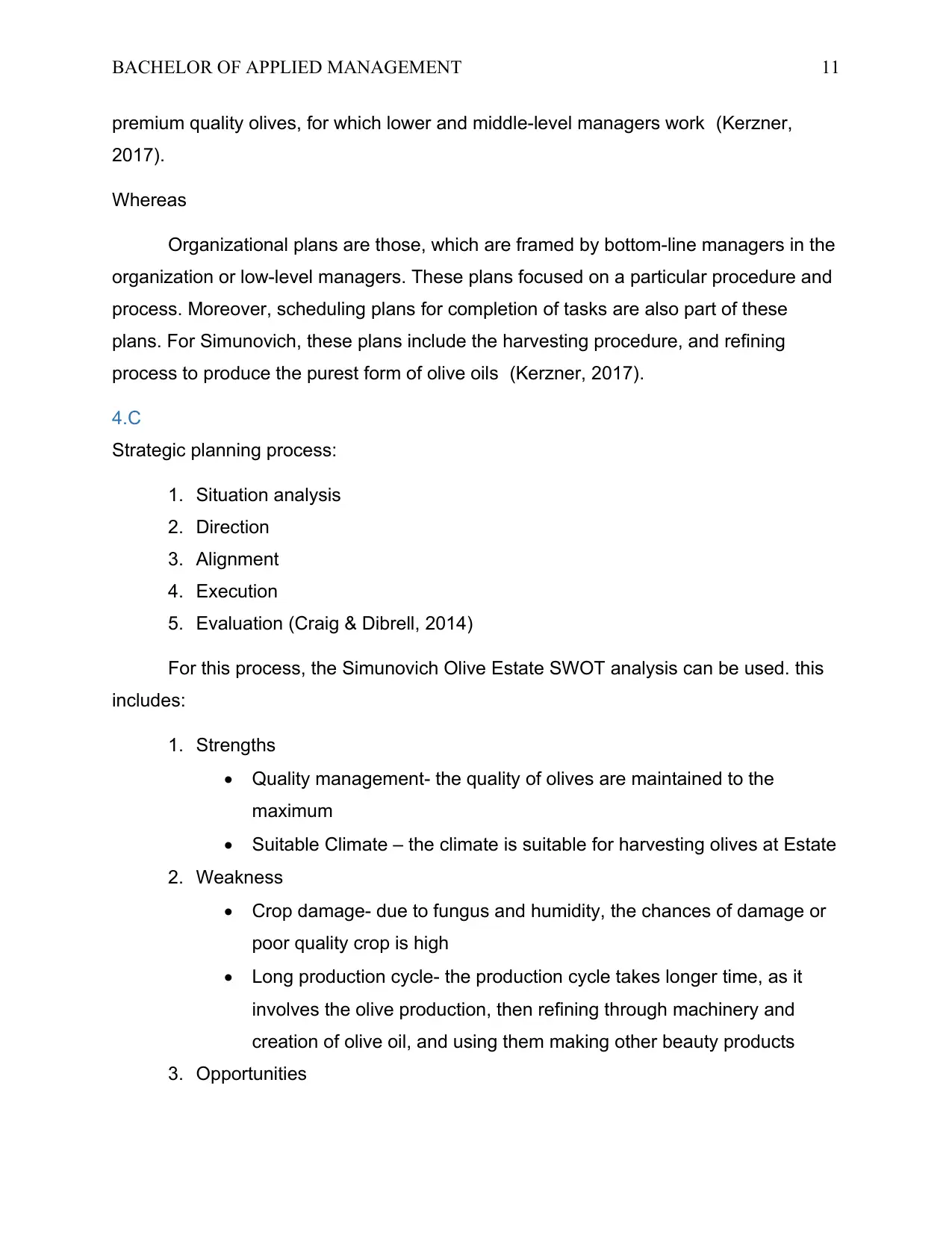
BACHELOR OF APPLIED MANAGEMENT 11
premium quality olives, for which lower and middle-level managers work (Kerzner,
2017).
Whereas
Organizational plans are those, which are framed by bottom-line managers in the
organization or low-level managers. These plans focused on a particular procedure and
process. Moreover, scheduling plans for completion of tasks are also part of these
plans. For Simunovich, these plans include the harvesting procedure, and refining
process to produce the purest form of olive oils (Kerzner, 2017).
4.C
Strategic planning process:
1. Situation analysis
2. Direction
3. Alignment
4. Execution
5. Evaluation (Craig & Dibrell, 2014)
For this process, the Simunovich Olive Estate SWOT analysis can be used. this
includes:
1. Strengths
Quality management- the quality of olives are maintained to the
maximum
Suitable Climate – the climate is suitable for harvesting olives at Estate
2. Weakness
Crop damage- due to fungus and humidity, the chances of damage or
poor quality crop is high
Long production cycle- the production cycle takes longer time, as it
involves the olive production, then refining through machinery and
creation of olive oil, and using them making other beauty products
3. Opportunities
premium quality olives, for which lower and middle-level managers work (Kerzner,
2017).
Whereas
Organizational plans are those, which are framed by bottom-line managers in the
organization or low-level managers. These plans focused on a particular procedure and
process. Moreover, scheduling plans for completion of tasks are also part of these
plans. For Simunovich, these plans include the harvesting procedure, and refining
process to produce the purest form of olive oils (Kerzner, 2017).
4.C
Strategic planning process:
1. Situation analysis
2. Direction
3. Alignment
4. Execution
5. Evaluation (Craig & Dibrell, 2014)
For this process, the Simunovich Olive Estate SWOT analysis can be used. this
includes:
1. Strengths
Quality management- the quality of olives are maintained to the
maximum
Suitable Climate – the climate is suitable for harvesting olives at Estate
2. Weakness
Crop damage- due to fungus and humidity, the chances of damage or
poor quality crop is high
Long production cycle- the production cycle takes longer time, as it
involves the olive production, then refining through machinery and
creation of olive oil, and using them making other beauty products
3. Opportunities
⊘ This is a preview!⊘
Do you want full access?
Subscribe today to unlock all pages.

Trusted by 1+ million students worldwide
1 out of 16
Related Documents
Your All-in-One AI-Powered Toolkit for Academic Success.
+13062052269
info@desklib.com
Available 24*7 on WhatsApp / Email
![[object Object]](/_next/static/media/star-bottom.7253800d.svg)
Unlock your academic potential
Copyright © 2020–2025 A2Z Services. All Rights Reserved. Developed and managed by ZUCOL.





